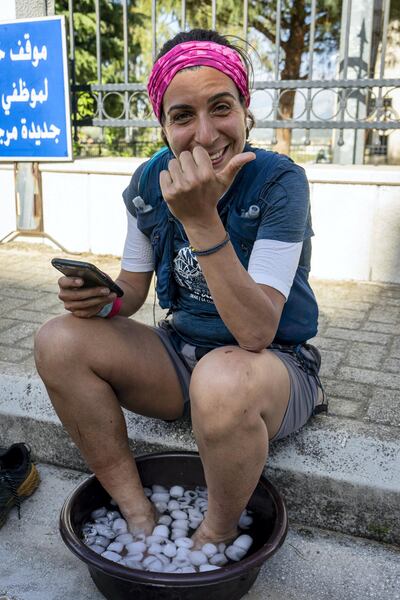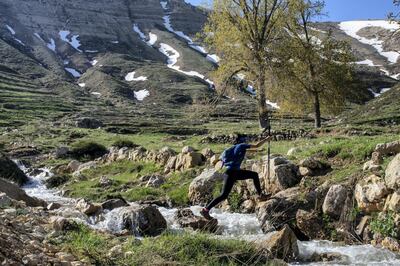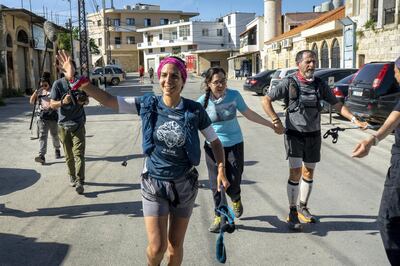Nayla Cortas pulls a deep inhale through gritted teeth, grimacing at the throbbing pain as the ice-cold water surrounds her swollen ankles and runs over her bruised and blistered toes.
She opens her eyes, red and exhausted, and stares into a plastic bowl where her feet are finally rested, fully submerged in a concoction of ice-water and antiseptic fluid.
"I ask myself, 'why am I doing this?'" Nayla tells The National in the quiet of the Iris Flower Hotel room in Jezzine.
It was the middle of the day, about 1.30pm, and Nayla and her friend and mentor Ali Kedami, had stopped to rest after running for more than 16 hours covering the 82km between Fallougha and Jezzine along the Lebanon Mountain Trail (LMT).
She would only have two more hours of respite, time enough to eat and get a brief nap, before getting up, pulling on her running shoes, and continuing towards the finish line of Marjaayoun … a further 81 kilometres away.
The thought of putting any more weight into her feet, shredded from the rough terrain of Lebanon’s mountains, was enough to bring tears to a tired and emotional Cortas.
“Maybe it’s infected. When I first saw my feet, I had thought that this would prevent me from continuing. I felt depressed after all this effort.”
It had been a monumental effort; this was the sixth day of an ultra-running challenge to traverse the entire 460km of the LMT in record time. In order to do that, Nayla and Ali would have to get to Marjaayoun in under 32 hours. The clock was ticking.
Cortas completing the run was never part of the plan; she had initially agreed to be a support runner for Kedami, an experienced ultra-runner with 14 ultra-marathon races and numerous long distance challenges under his belt.
It was his project to run the LMT in record time and he had asked for Nayla to start with him; that she could stop and rest whenever she wanted to.
“He told me if I feel I am able to do it, to continue. I didn't want to have pressure to finish,” remembers Cortas.
At this point, there was nothing more alluring to her than the desire to stop. Cortas was sleep-deprived, her body was aching for stillness, yet she had come so far.
It was 4.08am on Sunday April 25, 2021, when Nayla and Ali first started running, setting off from the northern town of Aandqet. Using headlamps to navigate the dirt roads and farm tracks in the darkness, they searched for the purple and white blazes that marked the way along the LMT.
They started strong, ascending and descending the mountains of northern Mount Lebanon at pace, knocking off the 80km of the first day almost entirely as per the schedule; by the end of day one they were already 20km before where the current record holder, Patrick Vaughan had spent his first night.
Their strategy to beat Vaughan’s fastest known time (FKT) of six days 17 hours and 25 minutes, had been to run slower but for longer, minimising the resting time. The initial schedule would have had them crossing the finishing line in less than six days.
However, the LMT that runs down the spine of Lebanon, connecting 76 towns and villages via historic footpaths and tracks, can easily foil the best-conceived plans.
Much of the trail includes steep climbs and sharp descents around jagged mountain sides and valleys, with around 20,000 meters of elevation from start to finish.
The terrain can be rocky, awkward and technical, and the trail-markers are often missing, washed away by the winter rains or difficult to find.
The intensity of the ups and downs weighed heavily on the knees of Kedami (59). This, along with the suffocating heat that sapped the runners’ energy; meant that their progress began to slow. By the end of the third day the pair had fallen around 40km short of their planned resting place, stopping in Aaqora.
“It’s too much,” an exhausted Kedami explained to the support-cum-film crew when talking about the concentration of elevation.
Fearing that the record would start to run away from them, they agreed on a new strategy that would preserve energy and keep them moving for approximately 18 hours per day.
“To break the record, we think we should stay in a tent for no more than five or six hours during the day, and run during the night, as the days are too hot.” Kedami explained during a run between Aaqoura and Baskinta.
With the help of the dedicated support crew, the runners planned the stopping points so they would sleep in tents along the trail when necessary, removing any time wasted travelling to and from guesthouses.
It was day three that the pain started to really set in for Cortas, with her ankles beginning to swell.
“I know this kind of pain; you feel it when you try to move, but can’t lift your foot from the ground,” Nayla remembers. “I thought, ‘That's it, it has started.’”
Any ultra-runner will confirm, enduring and managing pain comes with the territory of the sport. During the months of training in the lead up to this event, Kedami and Cortas’ training had included building up a higher threshold for pain, as well as for their body to endure longer distances while taking on less water.
As a pharmacist by trade, Cortas came prepared with remedies, using every resting stop as an opportunity to apply a combination of anti-inflammatory creams, sprays and pain relief to her feet and ankles.
“I needed to act quickly to prevent it from getting worse,” says Cortas.
As the days wore on, it wasn’t just the physical ailments or unforgiving terrain that burdened each step. An intense mental battle raged in the minds of both athletes. Nayla found herself battling the overwhelming sensations of depression as she ran in silence for hours along the trail.
“The worst moments were when I felt lonely, I don’t know why.” Cortas would use her breaks to try to connect with her friends and family. “Time was running quickly, you need to talk to your mom, to your friends but no one is around.”
Support was at hand. As Kedami and Cortas pressed on further towards the finish, their efforts caught the attention of the Lebanese running community on social media. Friends who they run with on weekends came up to pace the final sections of the trail, a much needed distraction.
“I consider them as very close friends, and we have been running trails a lot together, we have a lot of memories,” says Cortas, “They make us forget the fatigue, the pain and the heat during the day.”
The support worked to lift the spirits of Cortas and Kedami. The change in strategy also worked, and as their bodies adapted to the continuous physical strain and recovered quicker during resting stops. As a result, they consistently racked up 70km on days four, five and six, chipping away at the deficit accumulated over the previous slower days.
Despite this, the initial target to finish in under six days became unobtainable. Kedami and Cortas would now aim to set a new record by as many hours as possible.
“I decided to direct the team towards another goal, that of accepting the idea of not being able to beat the record. After the pressure was released, I was able to concentrate on a new strategy,” explains Kedami.
During the final sections the pair found themselves in esteemed company, supported by both Avedis Kalpaklian, the first man to set a fastest known time on the LMT and by current record-holder Vaughan.
“I’m excited, I told Ali four years ago I wanted him to break the record, when he helped me set it then (in 2017). So I have been looking forward to this, and having Nayla do it as well is super exciting,” said Vaughan.
Kedami and Cortas set off on the final stretch from Jezzine at 15.55pm, knowing they wouldn’t sleep again until they crossed the Beqaa Valley some 11 hours later. With a team of support runners and aid stations set up along the way, they pressed on.
As the sun climbed into the morphing skies over Mount Hermon, Kedami and Cortas arose from a brief nap at Rachaiya. Cortas once again cleaned and redressed her calloused feet for the final push towards Marjaayoun. It was the seventh day, every hour that passed brought with it the weight of expectation. Would they make it in time?
“I just want this to be over,” Cortas said at one point. Whatever happens now, stopping was not an option.
Finally they could see it, the historic town of Marjaayoun, on top of of a hillside skirted with refugee settlements, the children of which came out to greet the runners. The final climb was 2km with 100 metres of ascent, the fitting end to a mammoth challenge.
Upon completing the last uphill, they rounded a corner passing through the town square towards the support crew, local TV stations and jubilant family and friends.
At 4.23pm on Saturday May1, 2021, Ali Kedami and Nayla Cortas completed the Lebanon Mountain Trail, setting a new FKT of six days, 12 hours and 15 minutes.
As they collected the hugs and high-fives from the team that had supported them through the week, the pair became overwhelmed with emotion and relief. Kedami was embraced by his daughter Saria, his main inspiration for running.
“In the worst moments of pain and the urge to quit I always hear my daughter Saria's voice telling me that we never give up,” Kedami said.
When Cortas crossed the line in Marjaayoun, she made history as the first woman to through-run the LMT.
She had spoken on the trail about how she had experienced societal pressures to act in a certain way, i.e. to cut down on the running and focus more on finding a partner and starting her own family. After her feet were once again submerged in ice water and antiseptic, Nayla had a clear message.
“I hope this inspires other women to challenge themselves, and be leaders in doing what they love. I hope they will be inspired to do what they love and not to care about other people's opinion,” she said.
Award-winning Lebanese filmmaker Bachar Khattar documented Nayla Cortas and Ali Kedami’s record-breaking run of the Lebanon Mountain Trail. The film is expected for release next year.






